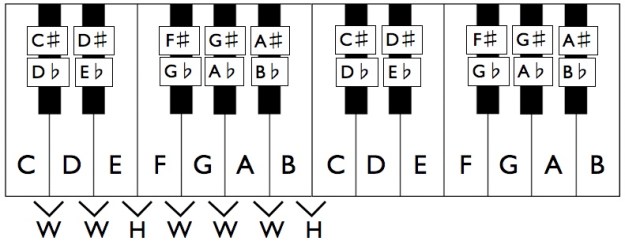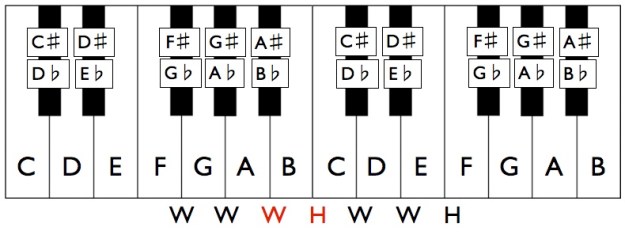In the Notes tutorial we learned about the pitches that make up music and how they are named. The next step is to group the notes in some logical/musical way. The foundation for this grouping in music theory is the Major scale. A large part of music theory is in some way based on the Major scale.

- As we learned in the notes tutorial there are seven notes named A to G and five in-between notes with names based on the notes they are beside. This makes twelve notes that repeat in higher and lower octaves
- Although you can play any of the 12 notes at any time it helps to have some structure to organize which notes to use

- One of the fundamental ways of organizing the notes is into the major scale
- Instead of using all 12 notes we select just 7 (that repeat in different octaves)
- It turns out that the most basic major scale, the C major scale, is played using only the white keys on piano keyboard
- The scale starts on C and contains the notes C-D-E-F-G-A-B
- The note a scale starts on and is named after is called the “tonic”. “Root note” is used as well

- What makes a scale sound the way it does is the series of steps between notes. If you change the spacing you get a different sounding scale
- We mentioned the “half step” (H) previously which is the distance between two consecutive notes. There is also the “whole step” (W) which is equivalent to two half steps
- The pattern for a major scale is: W W H W W W H as labeled above
- Notice that the half steps in the C major scale are between E-F and B-C (where there are no black keys)

- What happens if we try to start from another note? Say G? We want to play a G major scale
- If we try to use just the white notes we run into a problem. Our formula doesn’t work. It’s a scale…but not a major scale…the part in red above is where we have the problem. Instead of W W H W W H we have W WH W W H W
- In order to fix the spacing we need to use a black key… the F# to get the correct pattern back. E to F# is a whole step and F# to G is a half step…order is restored
- The G major scale has these notes: G A B C D E F#

- How about D Major? If we try to just use the white notes we run into the same problem as before. Our formula doesn’t fit. But it seems to be broken in two places.
- In order to fix the spacing we need to use two black keys… the F# to change the H to a W and C# to change the W to an H
- The notes in the D major scale are D E F# G A B C#

- The notes in the D major scale are D E F# G A B C#
- Since the black notes have two names why did we use F# and not G♭ or C# and not D♭
- Although the full explanation is beyond the scope of this tutorial this is what it would look like if we did: D E G♭ G A B D♭
- Looks pretty strange… two version of G and two versions of D… by using the sharps we ensure that each letter name is used only once
- We’ve covered three Major scales so far: C (no sharps), G (one sharp) and D ( two sharps)
- There’s a pattern. We’re adding sharps as we go along. Below is C and all the sharp keys
| Number of sharps | Major Key | Notes |
|---|---|---|
| 0 | C | C D E F G A B |
| 1 | G | G A B C D E F# |
| 2 | D | D E F#G A B C# |
| 3 | A | A B C# D E F# G# |
| 4 | E | E F# G# A B C# D# |
| 5 | B | B C# D# E F# G# A# |
| 6 | F# | F# G# A# B C# D# E# |
| 7 | C# | C# D# E# F# G# A# B# |

- What’s the deal with E# and B#? There are no black keys for those notes?!!
- Since there are seven sharp keys we need seven sharps. E# and B# are necessary. But how would the E# or B# fit into the keyboard. You have to go back to the definition of sharp….one half step higher
- To play E# you’d actually just play an F and for B# you’d actually play a C. However in the context of the key (and the goal of each letter name being used once) it makes more sense to think of them as E# and B#
…and now the flat keys

- Once you understand how the sharp keys are built understanding the flat keys should be simple
- As you can guess starting from F would give us a problem. Our major scale pattern is once again not right. This time a sharp won’t help to fix the problem
- By changing B to B♭ the major scale pattern is restored
- The F major scale has these notes: F G A B♭ C D E
- Just like with the sharp keys the pattern is to add flats one at a time
- As you’d expect there are seven flat keys. Below is C and all the flat keys
| Number of flats | Major Key | Notes |
|---|---|---|
| 0 | C | C D E F G A B |
| 1 | F | F G A B♭ C D E |
| 2 | B♭ | B♭ C D E♭ F G A |
| 3 | E♭ | E♭ F G A♭ B♭ C D |
| 4 | A♭ | A♭ B♭ C D♭ E♭ F G |
| 5 | D♭ | D♭ E♭ F G♭ A♭ B♭ C |
| 6 | G♭ | G♭ A♭ B♭ C♭ D♭ E♭ F |
| 7 | C♭ | C♭ D♭ E♭ F♭ G♭ A♭ B♭ |
Summary
- Scales are a way of organizing the notes we use
- The Major scale is created by using the whole/half step pattern: W W H W W W H
- C Major has no sharps or flats. On the piano keyboard it’s made up of just the white keys
- When starting from other notes sharps or flats are needed to maintain the pattern
- There are seven sharp keys and seven flat keys
- The note that the scale is named after is called the “tonic”. “Root note” is used as well
Back: Musical Notes Next: Intervals